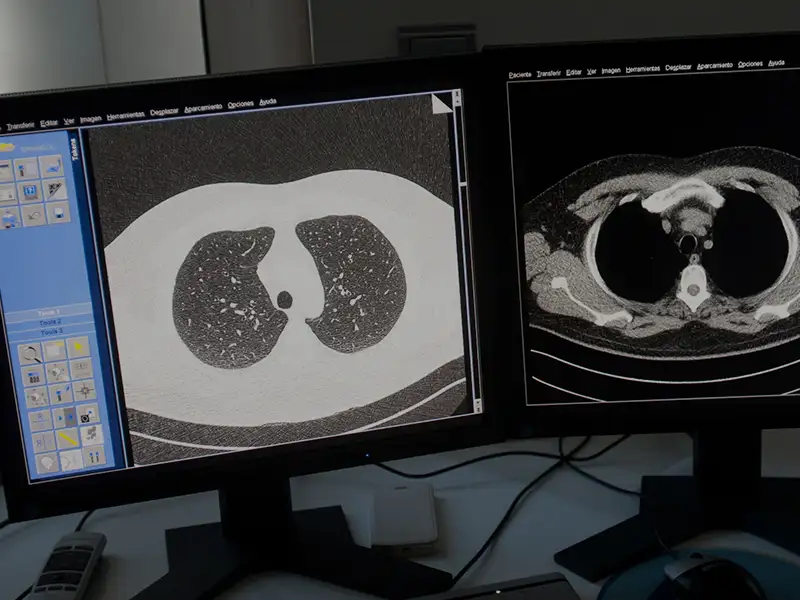Lung Cancer
"Performing an annual chest CT scan on people at risk helps to reduce lung cancer mortality".
DR. MARÍA RODRÍGUEZ
COORDINATOR. LUNG CANCER AREA

What is lung cancer?
Lung cancer is a type of tumor that develops when lung cells grow excessively and uncontrollably. This type of cancer originates in the cells of lung tissue or the bronchi, causing local problems due to space occupation and compression of nearby structures. In addition, it can spread through the lymph nodes and/or blood vessels, leading to metastases in other organs of the body.
Lung cancer is one of the most common and most aggressive cancers, with survival rates becoming more compromised as it spreads to other organs. This is why early diagnosis is crucial. Detecting the disease at an early stage is essential to achieving a cure in up to 90% of patients when there is no invasion of neighboring structures or distant metastases.
The Clínica Universidad de Navarra is a pioneer in Spain with its Early Detection Program for Lung Cancer. Led by a highly qualified team, the program offers rapid and accurate annual low-dose chest CT scans for individuals at risk.
Through this program, 85% of lung cancers have been diagnosed at early stages, allowing for patient cure through surgery.
The Lung Cancer Area of the Cancer Center Clínica Universidad de Navarra, with more than 35 years of experience, offers top specialists and the most advanced techniques to achieve the cure of lung cancer.

A PERSONALIZED MEDICINE
Second Opinion,
peace of mind
Request a second opinion from our professionals with great experience in the diagnosis and treatment of oncological diseases
In 3 days, without leaving home.
What are the symptoms of lung cancer?
In almost two-thirds of cases, lung cancer causes no symptoms, or the symptoms are very nonspecific (fatigue, loss of appetite, weight loss, etc.) or similar to those of other benign diseases. This is why, in most cases, diagnosis occurs at advanced stages.
When symptoms do appear—caused by local tumor growth and invasion of neighboring lung structures—the most common is a persistent cough, with or without sputum production, occurring in 45–75% of patients.
On the other hand, hemoptysis, or coughing up blood, occurs in some cases—in up to 50% of patients with lung cancer. Another symptom is dyspnea, or the sensation of shortness of breath, usually caused by the occupation of lung space that prevents proper airflow.
In other cases, symptoms arise from the presence of distant metastases, most commonly affecting the lymph nodes, bones, brain, liver, and adrenal glands.
Finally, there are a series of symptoms produced by so-called paraneoplastic syndromes (symptoms not directly caused by the tumor), which result from the inappropriate secretion of substances by the tumor.
Do you have any of these symptoms?
If you suspect that you have any of the above symptoms,
you should consult a medical specialist for a diagnosis.
What are the causes?
Tobacco is the cause of lung cancer in more than 80% of cases. The lifetime risk of developing lung cancer for a chronic smoker can reach up to 30%, while for non-smokers it is about 1%. The risk depends on the number of cigarettes smoked per day, as well as the number of years the person has smoked.
After quitting smoking, the risk of developing lung cancer decreases over the years, although elevated risk levels can persist for several years after quitting the habit.
Other factors, in addition to passive smoking, include exposure to asbestos, polycyclic aromatic hydrocarbons, arsenic, and nickel, as well as having other lung diseases such as chronic obstructive pulmonary disease (COPD) and/or pulmonary fibrosis.
Lung cancer and smoking cessation
Seventy percent of smokers want to quit smoking permanently and express this intention in the medium or long term. However, most encounter significant difficulties.
Strong personal motivation and support from those around them are required. In most cases, several attempts are necessary.
Participating in a Smoking Cessation Program, such as the one offered by the Clínica Universidad de Navarra, substantially increases the chances of successfully quitting smoking. It provides support and follow-up by pulmonologists and specialized nurses.
The program includes a Pulmonology consultation, spirometry testing, the use of highly effective medications when needed, as well as a nursing session and personalized follow-up.
It is a personal motivational reinforcement aimed at achieving the definitive abandonment of the smoking habit.
How is lung cancer diagnosed?
To diagnose lung cancer, several tests are necessary, which may include:
- Medical history and physical examination
- General blood tests
- Chest X-ray
- Chest CT scan
- Brain CT scan or magnetic resonance imaging (MRI)
- PET scan
- Pulmonary function tests
In most cases where the above tests suggest the presence of lung cancer, additional endoscopic studies are needed to obtain a tissue sample in order to determine the type of tumor, its prognosis, and the most appropriate treatments.
- Bronchoscopy
- Transthoracic needle aspiration
- Endobronchial or endoscopic ultrasound (EBUS/EUS)
- Mediastinoscopy
Treatments for lung cancer
In the treatment of lung cancer, it is essential to have a multidisciplinary team that assesses each case individually
When lung cancer is localised, a surgical approach is possible and the patient can be cured in a high percentage of cases.
To know if surgery is possible, the resectability of the lesion and the operability of the patient must be assessed, and respiratory function tests must be performed to determine whether the respiratory reserve remaining after surgery will be sufficient for the patient to breathe.
Existing surgical procedures to consider:
- Lobectomy: removal of one lobe of the lung, applicable to patients with adequate respiratory reserve, which minimises the likelihood of localised recurrence.
- Pneumonectomy: removal of the entire lung.
- Segmentectomy or wedge resection: removal of part of a lobe. It is performed in patients with impaired respiratory function.
In cases of disseminated disease at diagnosis, surgery may also be a valid therapeutic strategy in selected cases: limited number of metastases, control of the primary tumour and operability of the patient.
Robotic surgery involves removing the pulmonary nodule through small incisions, through which the robot’s instruments are inserted. Thanks to robotic technology, the surgeon can perform the procedure using incisions no larger than one centimeter.
This is a minimally invasive surgery that allows us to perform procedures that are far less aggressive for the patient, with faster recovery, fewer complications, and greater safety.
The use of the surgical robot provides greater precision, enhanced visualization, and optimized treatment. It eliminates hand tremors, offers significantly magnified vision (tenfold), and improves surgical control.
Almost all surgeries required to treat lung cancer can be performed using the robotic approach.
In addition, the Clínica Universidad de Navarra implements Enhanced Recovery After Surgery (ERAS) protocols aimed at reducing pain, shortening hospital stays, and minimizing potential complications associated with surgery. Through the multidisciplinary work of specialists, including highly trained nursing staff in the latest available advances, patients experience an accelerated recovery, enabling them to return to their daily activities more easily.
Chemotherapy can be administered in several therapeutic modalities:
- Adjuvant treatment: after complete surgery in patients who have undergone curative resection.
- Neoadjuvant treatment: administered prior to potential surgical resection with the goal of reducing tumor size.
- Palliative treatment: in the context of disseminated disease.
Currently, obtaining the most precise histological and/or molecular diagnosis possible is essential to ensure that the chosen chemotherapy regimen is the most appropriate for each case. The potential survival benefit and risk of toxicity should be discussed individually with the medical and nursing team.
The Clinic has a Symptom Control and Palliative Care Service, recognized by the European Society for Medical Oncology (ESMO) as a center of excellence, providing comprehensive patient care in conjunction with medical treatment to maximize both survival and quality of life.
Radiotherapy can be used, either in combination with chemotherapy or alone, in the following situations:
- Patients with lung tumors that are inoperable due to their location and/or size.
- Operable patients who are not candidates for surgical treatment.
- Patients with metastatic disease, for symptom control (e.g., bone metastases causing pain, brain involvement leading to seizures, etc.).
- Patients who, due to personal preference, decline surgery.
The Clinic has extensive experience in administering both external and internal radiotherapy. In addition, its Madrid location houses the most advanced Proton Therapy Unit in Europe and the first within a cancer center, supported by comprehensive clinical care, academic and research resources, and the services of a highly specialized hospital.
Immunotherapy, as a standalone treatment strategy or in combination with chemotherapy and/or radiotherapy, represents one of the major recent advances in the treatment of lung cancer.
The Cancer Center has been a pioneer in its development and implementation, with a comprehensive program that integrates basic and translational research (Immunology and Immunotherapy Program) with the clinical application of new therapeutic approaches (Onco-Hematology Program).
The Cancer Center has an Advanced Therapies Unit, equipped with the technology and facilities required for the production of all immunotherapy products related to adaptive cell therapy.
Lung cancer is the paradigm of a tumor with personalized treatment. Accurate diagnosis involves identifying the molecular alterations (mutations, translocations, etc.) present in each tumor, which makes it possible to offer patients treatment options targeted to those specific alterations found in these analyses.
This approach to the specific therapeutic targets of each patient is part of the Personalized Oncology strategy carried out at the Cancer Center of the Clínica Universidad de Navarra.
The goal is to identify the available therapy that offers the maximum benefit with the minimum risk of side effects for each patient, significantly improving survival and quality of life. At the CCUN, various clinical trials are also conducted to validate the usefulness of new drugs or drug combinations.
The Cancer Center works in close collaboration with Cima Lab Diagnostics, which has the facilities and technology required for the analysis of these biomarkers (predictive and/or diagnostic) that enable the individualized treatment of the main tumor types.
The Solid Tumors program at Cima Universidad de Navarra conducts research to identify new therapeutic targets, new markers for early diagnosis, prognosis and prediction of drug response, as well as new personalized strategies for the management and treatment of various types of lung cancer.
The Cancer Center also has a Clinical Trials Unit with a careful selection of immunotherapy clinical trials, targeted therapies and other therapeutic approaches, which maximize the therapeutic options for our patients.
Early lung cancer detection
Our Early Lung Cancer Detection Program has been running for 20 years.
The program includes an annual chest CT scan to monitor and detect cancer in the early stages, when tumors can be cured.
What clinical trials do we have on Lung Cancer?
Proton therapy for cancer
Proton therapy is the most precise external radiotherapy modality, providing better distribution of radiation dose and therefore less irradiation of healthy tissues.
The Proton Therapy Unit of the Cancer Center Clínica Universidad de Navarra in its Madrid headquarters is the most advanced in Europe and the first in a Cancer Center, with all its healthcare, academic and research support.
Where do we treat it?
IN NAVARRE AND MADRID
The Lung Cancer Area
of the Cancer Center Clínica Universidad de Navarra
The Lung Cancer Area is made up of specialists in Pneumology, Medical Oncology, Radiation Oncology, Thoracic Surgery, Radiology, Nuclear Medicine and Pathological Anatomy, as well as researchers from the Solid Tumors and Biomarkers Program at the Summit.
The diagnostic process integrates tumor molecular biology to achieve the most complete diagnosis possible.
Diseases we treat

Why at the Clinica?
- Integral evaluation of the patient.
- Possibility of beginning personalized treatment 48 hours after the first consultation.
- Minimally invasive surgery for the prompt recovery of our patients.
IN NAVARRE AND MADRID












































